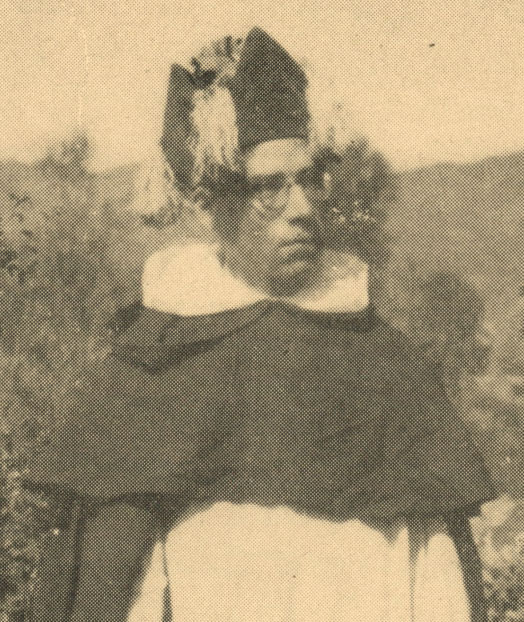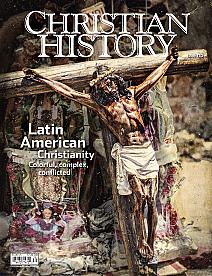A NEW DAY FOR WALTER MONTAÑO, THE MONK WHO LIVED AGAIN

[ABOVE—Montaño on the morning he found salvation in 1927, from The Monk Who Lived Again]
IN 1938, when Mexico’s President Lázaro Cárdenas warmly welcomed Protestant evangelist Dr. Walter Montaño, two men with improbable backgrounds met. Cárdenas had overcome a limited education and prejudice against him because of his Indian heritage to become a notable general. He had worked tirelessly to build a coalition to win Mexico’s presidency. Consequently, he was willing to reach out to the growing Protestant community in Mexico although it numbered less than 100,000. (By 1946, thanks in part to Montaño, it would exceed a quarter million.) Recent revolutions in Mexico had loosened the grip of the Roman Catholic Church and reduced the negative repercussions for Cárdenas meeting and greeting a “heretic.”
For his part, just twelve years earlier, Dr. Walter Montaño had been Fray Luis, a trusted Dominican in a Peruvian monastery. Spiritually hungry, he was increasingly disenchanted with his religious community. Appointed secretary to a Dominican inquisitor, he had to type up the confessions of the priests of the Lima monastery. He said he was horrified to discover that the majority admitted seducing parishioners, committing thefts, and even participating in murders. Priests regaled each other with shameful revelations they heard in confessional. He was also uneasy about an order to write a biography of a lowly servant, Martin Porres, that was to include numerous inventions and fabricated miracles to ensure that the pope would beatify the Indian. Above all, Fray Luis longed to know for certain he possessed eternal life, but was told no such knowledge was possible before death.
Placed in charge of the convent library, he encountered restricted Protestant works. As he read them, these worked on his soul. Finally Fray Luis could bear the tension no longer. Early in the morning of this day, 3 January 1927, he fled the monastery and went to see Evangelical Union of South American Workers. There he unburdened his soul. Missionary Charles A. Patton showed him the way of salvation. After five hours on his knees, Montaño rose as a new man in Christ Jesus. Almost immediately he began evangelistic work. He would be referred to as “The Monk Who Lived Again.”
His family disowned him, authorities harassed him, Rome excommunicated him, and assassins attempted to take his life. When his father cast him off from his family, Montaño replied, “If you have denied me, still I have a Father who is in heaven. Not for anything . . . can I deny the experience of peace and salvation which he has given to me and the joy that is mine.”
He even spent time in the foul, pitch dark “hole” of the jail at Puno, near Lake Titicaca because of his conversion testimony. Eventually he was moved to a filthy common cell where violent criminals, beggars, and madmen surrounded him. He spoke to the guards about Christ. Days later he was transferred to Cuzco for trial and deported to Bolivia. Montaño preached there until persecution forced him out.
At the invitation of famed mission pioneer Harry Strachen, he accepted a position at the Bible Institute of Costa Rica where he met Esther Piper who became his wife. A few years later, Montaño returned to preach in Peru. Again he was jailed, this time at Huancayo—accused of being a Communist—but he produced a letter from Peru’s president that enabled him to obtain his freedom. By 1938 he had preached throughout Latin America and in the United States.
Thousands attended Montaño’s Mexican meetings. In Vera Cruz so many inquirers overwhelmed the hall that workers begged for another meeting. Montaño jokingly suggested 4:30 the next morning and was accepted. The hall could not hold the thousands who showed up at that early hour and crowded the streets outside, unable to get in.
Before his death in 1981, Dr. Walter Montaño had preached to hundreds of thousands of Latin Americans. From 1951 to 1960 he headed Christ’s Mission, a New York-based evangelical outreach to Catholics, operated by ex-Catholic priests, and he edited the Converted Catholic (renamed Christian Heritage) magazine. In 1960 he resigned those positions to become president of the Western Hemisphere Evangelical Union. He authored Behind the Purple Curtain, describing the spiritual darkness of Latin America, and documenting many instances of Roman Catholic persecution of Protestants in South and Central America. His tombstone describes him as a theologian, diplomat, and humanitarian, the “Martin Luther of the Americans.”
—Dan Graves
- - - - - -
For more on Christianity in Latin America, read Christian History 130: Latin American Christianity: Colorful, complex, conflicted






